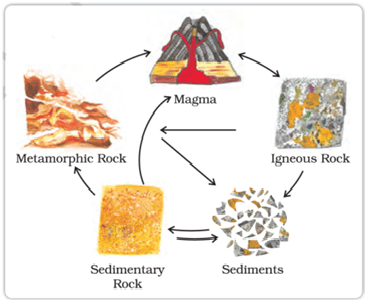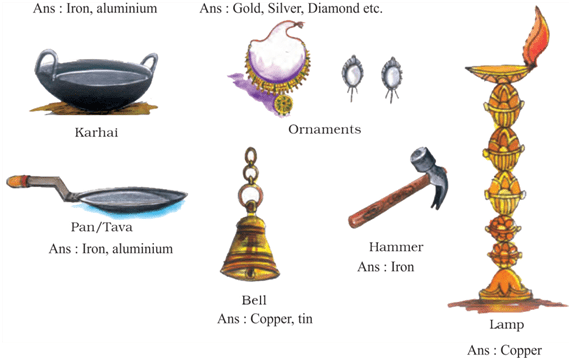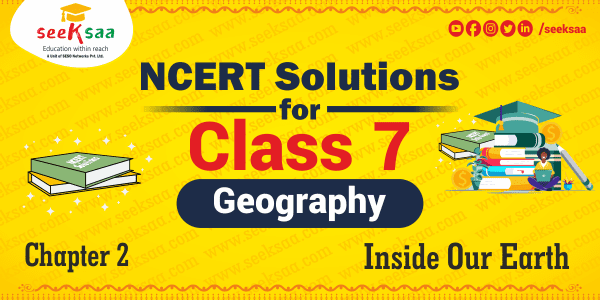| Section | Topic Name |
|---|---|
| 2 | Interior of the Earth |
| 2.1 | Rock and Minerals |
| 2.2 | Rock Cycle |
Q 1- Answer the following questions.
(i) What are the three layers of the earth?
Ans :- The three layers of the earth are :-
i) Crust – the uppermost layer.
ii) Mental – the middle layer.
iii) Core – the inner most layer.
(ii) What is a rock?
Ans :- Any natural mass of mineral matter that makes up the earth’s crust is called a rock.
(iii) Name three types of rocks.
Ans :- Three types of rocks are :-
i) Igneous rocks
ii) Sedimentary rocks
iii) Metamorphic rocks
(iv) How are extrusive and intrusive rocks formed?
Ans-

Intrusive rocks – When the molten magma coming out of the earth, cools down deep inside the earth’s crust. It forms intrusive igneous rocks.
Extrusive rocks – When the molten magma comes out of the earth, it cools down rapidly on the surface of the earth to form extrusive igneous rocks.
(v) What do you mean by a rock cycle?
Ans:- The process of transformation of rocks from one form to another due to extreme heat and pressure is called rock cycle.
(vi) What are the uses of rocks?
Ans :- Rocks can be used for :-
(i) Construction of roads and buildings.
(ii) Obtaining minerals like coal, iron etc.
(iii) Grinding of spices and grains.
(vii) What are metamorphic rocks?
Ans :- Rocks arising from the transformation of existing rocks into new types of rocks through the process of metamorphism, is called metamorphic rock.
Example : Slate, Marble etc.
Q 2- Tick the correct answer.
(i) The rock which is made up of molten magma is
(a) Igneous (b) Sedimentary (c) Metamorphic
Ans :- (a) Igneous
(ii) The innermost layer of the earth is
(a) Crust (b) Core (c) Mantle
Ans:- (b) Core
(iii) Gold, petroleum and coal are examples of
(a) Rocks (b) Minerals (c) Fossils
Ans :- (b) Minerals
(iv) Rocks which contain fossils are
(a) Sedimentary rocks (b) Metamorphic rocks (c) Igneous rocks
Ans :- (b) Metamorphic rocks
(v) The thinnest layer of the earth is
(a) Crust (b) Mantle (c) Core
Ans :- (a) Crust
Q 3– Match the following.
(i) Core (a) Earth’s surface
(ii) Minerals (b) Used for roads and buildings
(iii) Rocks (c) Made of silicon and alumina
(iv) Clay (d) Has definite chemical composition
(v) Sial (e) Innermost layer
(f) Changes into slate
(g) Process of transformation of the rock
Ans :- (i) (e)
(ii) (d)
(iii) (b)
(iv) (f)
(v) (c)
Q 4- Give reasons.
(i) We can not go to the center of the earth.
Reasons – We can not go to the center of the earth because the center lies in the 3rd layer i.e. core which has very high temperature and pressure.
This layers remains in molten state due to high temperature.
(ii) Sedimentary rocks are formed from sediments.
Reasons – Sediments of igneous rocks are transported by water and wind and deposited at some place.
These depositions when undergo high temperature and pressure, sedimentary rocks are formed.
(iii) Limestone is changed into marble.
Ans- Limestone when subjected to high temperature and pressure, it changes its form to become marble.
Q 5– For fun.
(i) What are the minerals most commonly used in the following objects?
Ans-

NCERT Solutions for Class 9 Science Chapter 4 Structure of Atom
NCERT Solutions for Class 9 Science Chapter 4 Structure of Atom Topics and Sub Topics in Class 9 Science Chapter 4 Structure of Atom: Structure of Atom Charged Particles in Matter The Structure of an Atom How are Electrons Distributed in Different Orbits (Shells)? Valency Atomic Number and Mass Number
NCERT Solutions for Class 8 Science Chapter 6 Combustion and Flame
NCERT Solutions for Class 8 Science Chapter 6 Combustion and Flame Topics and Sub Topics in Class 8 Science Chapter 6 Materials combustion and flame: Section Name Topic Name 6 Materials combustion and flame 6.1 What is Combustion? 6.2 How Do We Control Fire? 6.3 Types of Combustion 6.4 Flame
NCERT Solutions for Class 8 Science Chapter 5
NCERT Solutions for Class 8 Science Chapter 5 Materials Coal and Petroleum Topics and Sub Topics in Class 8 Science Chapter 5 Materials Coal and Petroleum: Section Name Topic Name 5 Materials Coal and Petroleum 5.1 Coal 5.2 Petroleum 5.3 Natural Gas 5.4 Some Natural Resources are Limited Coal and



